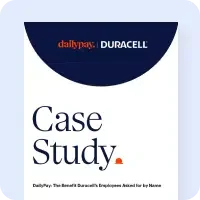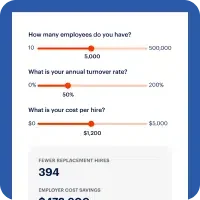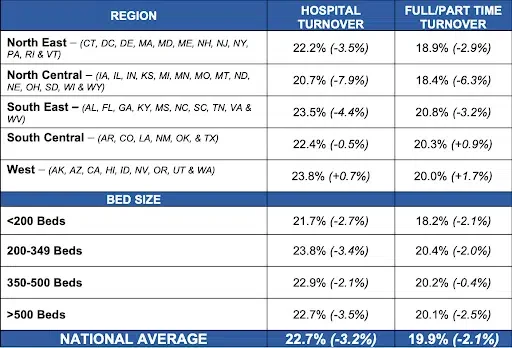In an earlier article, we discussed employee retention rate by industry and looked at which industries have the best and worst employee retention rates. In this article, we take a closer look at the healthcare industry. To learn about how employers can address turnover in healthcare, visit our healthcare industry page.
In the last five years, the average hospital turned over 100.5% of its workforce.1
The global workforce has been reshaped over the past few years, including the healthcare industry. According to the 2023 NSI National Healthcare Retention & RN Staffing Report, the hospital turnover rate stands at 22.7%, a 3.2% decrease from 2021, and Registered Nurse turnover is recorded at 22.5%, a 4.6% decrease.2
Although employee exits decreased in the latter half of 2022, labor shortages, employee burnout and retirement has kept hospital turnover rates elevated. In the last five years, hospitals have turned over 105% of their staff.3 Further data shows that voluntary terminations accounted for 94.7% of all hospital separations.4 For 2023, hospitals aim to decrease turnover by 3.8%.5
According to the NSI Report, all Registered Nurse specialties – except Labor & Delivery RNs – experienced an increase in time-to-fill. Not only is the healthcare industry experiencing high turnover rates, recruiting is getting tougher. Medical/surgical Registered Nurses were the most difficult to hire, adding 22 days of recruitment time. In 2023 it takes 91 to 120 days to fill an experienced medical/surgical RN, with the average being 105 days.6
The average cost of turnover for a bedside Registered Nurse is more than $52,350, costing the average hospital between $6.6 million and $10.5 million per year. With each percentage point increase or decrease in the Registered Nurse turnover rate, hospitals will lose or save $380,600 per year.7
The Registered Nurse vacancy rate within hospitals currently stands at 17%, which is up 7.1 points since last year,1 but the healthcare industry is still growing. The U.S. Bureau of Labor Statistics estimates the employment of Registered Nurses and healthcare practitioners in the diagnosis and treatment fields will grow about as fast as the average for all other occupations between 2020 and 2030.8
As labor gaps grow, it’s important to identify the areas within the healthcare industry that are particularly susceptible to turnover and learn what can be done to slow rates.
Retention Patterns in Healthcare
The 2023 NSI Report, revealed several patterns of turnover.
2023 Turnover by Position
- Staff Registered Nurses: 22.5%
- Certified Nursing Assistant (CNA): 33.7%
- Physician Assistant (PA): 13.5%
- Physical Therapist: 12.6%
- Medical Technologist: 17.8%
- Pharmacist: 10.6%
- Radiologic Technologist: 10.2%
- Patient Care Tech (PCT): 32.3%
By Demographic
There are a variety of factors that come into play when trying to discern turnover reasons. Location and position are factors, but additionally, age may play a role in turnover rates, especially for primary care physicians in rural areas.
By Tenure
- 39.8% of all new hires left within a year, accounting for 31.4% of all healthcare turnover.9
- 58.7% of employees who left spent less than two years in their position.10
By Facility
- The current turnover rate for hospitals is 22.7%, down 3.2% from the previous year.11
- South Central U.S. (AR, CO, LA, NM, OK, TX) sits at 22.4%.12
- North Central U.S. (IA, ND, NE, OH, SD, WI, WY, IL, IN, KS, MI, MN, MO & MT) has the lowest regional turnover at 20.7%.13
- Hospitals with less than 200 beds have the lowest turnover rates (21.7%).14
- Hospitals with 200–349 beds have the highest turnover rates (23.8%).15
Hardest Positions To Fill
Long periods of unfilled positions contribute to high turnover rates. And, while the nursing shortage has received a lot of media attention, it’s getting even more difficult to recruit.
According to the 2023 RN Staffing Report, here’s how long it takes to hire different Registered Nurse specialities.
- Medical/surgical RN – 105 days
- Critical Care RN – 99 days
- Operating Room RN – 98 days
- Progressive Care Unit RN – 96 days
- Telemetry RN – 95 days
- Emergency Room RN – 92 days
- Labor and Delivery – 75 days
The longer a job goes unfilled, the more it impacts a hospital’s bottom line, and clinical personnel aren’t the only difficult-to-fill positions. A study reported by First Coast Billing revealed what non-clinical roles are most difficult to fill.
- Business operations support staff turnover: 9.92%
- Clinical support staff turnover: 15.83%
- Front office support staff turnover: 20%
As you can see, the high turnover for primary care single specialties is most prevalent with front-office staff. For many physicians’ offices, this can be detrimental to quality care and customer service, as the front-office staff is often recognized as the face of the business.
The Cost of Turnover and Staffing Gaps
There are many factors that go into the true cost of turnover. For example, when a healthcare professional leaves, the hospital must account for:
- Staffing costs (e.g., overtime payouts, agency nurses, travel nurses)
- Continuity of care
- Training costs
- Staff workloads
- Accident rates
- Absenteeism
- Medical staff dissatisfaction
Not to mention, programs like those dedicated to mentorship and professional development worsen as the staff tenure decreases.
Industry experts estimate the average cost of turnover across all occupations in the healthcare industry can range up to 150% of a mid-level employee’s salary16. For example, the average cost of turnover for a bedside RN is estimated at $52,350. Given the 13.5% increase in cost from the previous year, the average hopital lost nearly $7 million last year.17
Why Turnover Is a Problem in the Healthcare Industry
Identifying why turnover is such a problem in the healthcare industry is the first step to resolving it. Common issues that perpetuate turnover numbers may include the following:
- Lack of workplace engagement
- Burnout symptoms of stress, anxiety, depression and sleep disturbances experienced during the pandemic
- A tight labor market and stiff competition for talent
- Baby boomers reaching retirement age and leaving vacancies
- Job hoppers
A key to solving the turnover problem lies in the ability to improve workplace engagement. Increased employee engagement can help to attract top talent in a competitive landscape and keep current employees happy, minimizing the risk of staff considering other job opportunities.
Recruiting, Engaging and Retaining Employees
The trifecta of recruiting, retaining and engaging employees is helpful to the success of multiple business objectives in healthcare.
Improve Retention Strategies
While turnover rates in the healthcare industry are notoriously high, many hospitals have implemented retention strategies but about 33.6% of hospitals currently have not tied them to measurable goals. Finding ways to increase tenure at your facility can help ease staffing gaps, improve patient care and evolve programs that maintain a well-trained arsenal of staff at your facility.
Focus on Employee Experience
We can all agree that bedside manner is an important component of a healthcare provider’s job. But, have you considered how your facility treats your staff? Across the board, HR departments are starting to realize that employee experience is a huge part of keeping employees engaged and happy in the workplace.
To offer an enhanced employee experience, facilities must get to the core of what their workforce wants from an employer, whether it be financial wellness, workplace flexibility or otherwise. Listening to employee feedback is a key ingredient for successful recruiting, retention and employee engagement.
Find Leverage in a Competitive Market
In today’s tight labor market, hospitals must differentiate themselves to attract and retain top talent. A survey conducted by The Harris Poll found that 73% of healthcare workers say it is important to them that their employer provides tools and resources to help them manage financial stress.18 Empowering employees with access to their earned pay before regularly scheduled pay cycles can help attract and retain top talent.
A solution to giving employees what they want can be found in on-demand pay. DailyPay is a benefit that gives your employees more control over when and how they receive their pay. DailyPay’s solution is designed to help alleviate financial burdens that may affect employees while simultaneously empowering them to make smarter financial decisions.
DailyPay is a viable and cost-effective benefit for many organizations. Not only are daily pay solutions non-disruptive to your current payroll process, they offer creative ways to inspire, motivate and fulfill employees.
Companies who offer on-demand pay see significant benefits:
- 71% of healthcare workers would be more likely to remain at a job if their employer offered an on-demand pay benefit than if they didn’t offer one.19
- 65% of healthcare workers say being able to track their earned wages on a daily basis would help alleviate financial stress.20
- 48% of users say they are more motivated to remain with their current employer because they offer DailyPay.21
- 67% of users say DailyPay has helped them reduce financial stress.22
With DailyPay, healthcare providers can care for their employees the way they expect their employees to care for their patients. In a new job market where employees hold more power than ever before – with more job choices, work options and revenue streams – employers must innovate and think of creative ways to attract and retain today’s top talent. On-demand pay is a customizable employee benefit healthcare workers can use to achieve greater financial wellness, and in return employers foster a more attractive, engaged and productive workforce.
To learn more about how DailyPay can help you create the healthcare staff of the future, schedule a live demo where we’ll walk you through all the powerful benefits today’s employees expect.
1 2023 NSI National Healthcare Retention & RN Staffing Report:DailyPay, 2020
2 2023 NSI National Healthcare Retention & RN Staffing Report:DailyPay, 2020
3 2023 NSI National Healthcare Retention & RN Staffing Report:DailyPay, 2020
4 2023 NSI National Healthcare Retention & RN Staffing Report:DailyPay, 2020
5 2023 NSI National Healthcare Retention & RN Staffing Report:DailyPay, 2020
6 2023 NSI National Healthcare Retention & RN Staffing Report:DailyPay, 2020
7 2023 NSI National Healthcare Retention & RN Staffing Report:DailyPay, 2020
8 BLS, 2022:DailyPay, 2020
9 2023 NSI National Healthcare Retention & RN Staffing Report:DailyPay, 2020
10 2023 NSI National Healthcare Retention & RN Staffing Report:DailyPay, 2020
11 2023 NSI National Healthcare Retention & RN Staffing Report:DailyPay, 2020
12 2023 NSI National Healthcare Retention & RN Staffing Report:DailyPay, 2020
13 2023 NSI National Healthcare Retention & RN Staffing Report:DailyPay, 2020
14 2023 NSI National Healthcare Retention & RN Staffing Report:DailyPay, 2020
15 2023 NSI National Healthcare Retention & RN Staffing Report:DailyPay, 2020
16 Arbor Associates, 2021:DailyPay, 2020
17 2023 NSI National Healthcare Retention & RN Staffing Report:DailyPay, 2020
18 Harris Poll survey commissioned by IntelyCare and DailyPay, November 2022 :DailyPay, 2020














